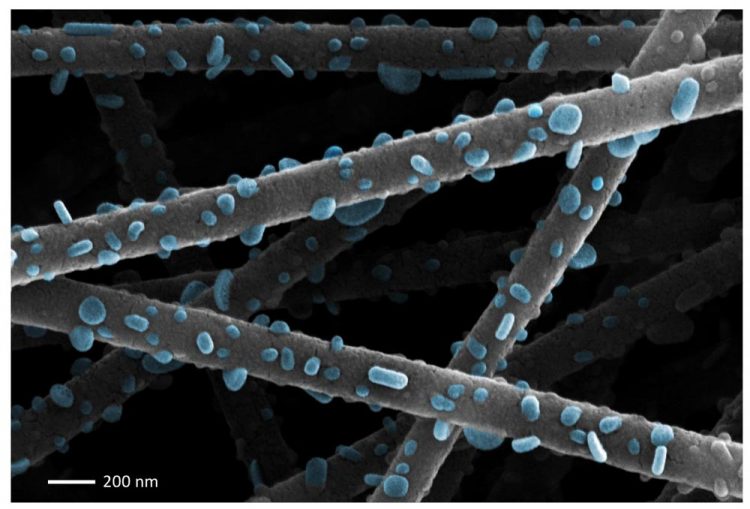Nano-scale process may speed arrival of cheaper hi-tech products

Nanoparticles are visible on the surface of a fuel cell produced by a technology known as electrospinning, which could speed the commercial development of devices, materials and technologies that exploit the physical properties of nanoparticles. Credit: Dr Norbert Radacsi
The process could speed the commercial development of devices, materials and technologies that exploit the physical properties of nanoparticles, which are thousands of times thinner than a human hair.
The particles' small size means they behave differently compared with conventional materials, and their unusual properties are inspiring research towards new applications.
Engineers demonstrated their manufacturing technique, known as electrospinning, by building a fuel cell – a device that converts fuels into electrical power without combustion.
Their device was produced featuring strands of nanoscale fibres incorporating nanoparticles on the surface. It offers a high contact area between the fuel cell components and the oxygen in the air, making it more efficient.
Researchers at the University of Edinburgh and California Institute of Technology built their fuel cell using a nozzle-free electrospinning device – a rotating drum in a bath of liquid under high voltage and temperature.
Nanofibres are produced from the liquid on the surface of the drum, which are spun onto an adjacent hot surface. As the fibres cool to form a fuel cell component, nanocrystals emerge on their surface, creating a large surface area.
Tests showed the nanofibre fuel cell performed better than conventional components. Such devices are very difficult to manufacture by other techniques, researchers say. The study, published in Nature Communications, was funded by the US Department of Energy.
Dr Norbert Radacsi, of the University of Edinburgh's School of Engineering, who led the study, said: “Our approach of electrospinning offers a quick and inexpensive way to form nanomaterials with high surface area. This could lead to products with improved performance, such as fuel cells, on an industrial scale.”
Media Contact
More Information:
http://dx.doi.org/10.1038/s41467-018-07243-5All latest news from the category: Power and Electrical Engineering
This topic covers issues related to energy generation, conversion, transportation and consumption and how the industry is addressing the challenge of energy efficiency in general.
innovations-report provides in-depth and informative reports and articles on subjects ranging from wind energy, fuel cell technology, solar energy, geothermal energy, petroleum, gas, nuclear engineering, alternative energy and energy efficiency to fusion, hydrogen and superconductor technologies.
Newest articles

First-of-its-kind study uses remote sensing to monitor plastic debris in rivers and lakes
Remote sensing creates a cost-effective solution to monitoring plastic pollution. A first-of-its-kind study from researchers at the University of Minnesota Twin Cities shows how remote sensing can help monitor and…

Laser-based artificial neuron mimics nerve cell functions at lightning speed
With a processing speed a billion times faster than nature, chip-based laser neuron could help advance AI tasks such as pattern recognition and sequence prediction. Researchers have developed a laser-based…

Optimising the processing of plastic waste
Just one look in the yellow bin reveals a colourful jumble of different types of plastic. However, the purer and more uniform plastic waste is, the easier it is to…



